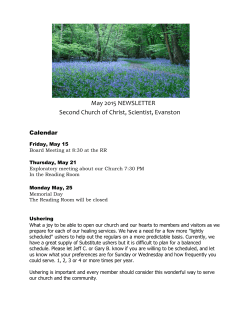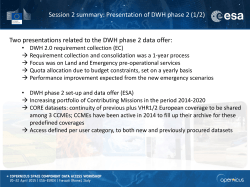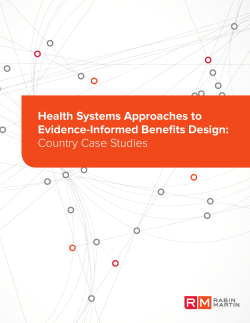
Tracing a User-Centered Design Process to Validate Guidelines for
Computerized decision support (CDS) has and will continue to be an important feature of Electronic Health Records (EHRs). On behalf of the Office of Knowledge Based Systems, Health Informatics, Office of Informatics and Analytics at the Veterans Health Administration, one of the authors published a draft formulation of Usability guidelines for Clinical Decision Support (Miller, 2014). The Draft Guidelines address past concerns about CDS by providing guidance about the presentation of CDS functionality in user interfaces (UIs) based on knowledge of human cognitive work and decision making in real-world healthcare environments. In order to assess the usability and utility of the Guidelines, a vendor team attempted to implement five CDS User Interface Interventions (CDS UI Interventions). The vendor team (comprising the first three authors and additional team members) followed a UserCentered Design (UCD) approach, implementing the CDS UI Interventions in wireframes, mockups and prototypes, and conducted formative and summative evaluations of the successive implementations. Tracing a User-Centered Design Process to Validate Guidelines for Clinical Decision Support Brian Moon1, Adam Way2, Emory Fry2, Anne Miller3, Diane Montella4 1 Perigean Technologies LLC, 2 Cognitive Medical Systems, Inc., 3 Vanderbilt University School of Medicine, 4 Office of Informatics and Analytics, Veterans Health Administration CDS(Interventions( of(Interest( Pending(Action/(Lost( to(FollowFup( (PA/LTF)( CDS( Guidelines( • • • OutFofFRange( NotiJications( (OORN)( • • • General(NotiJications( (GN)( • • • • • Effort&focused&on&a&por0on&of&the& UCD&process,&covering&design& through&mul0ple&itera0ons&of& evalua0on&and&development.& Sample(Formative(( Feedback( Facilitate&rapid&situa0on&assessment&in& rou0ne&situa0ons& Support&plans&in&ac0on&by&0ghtly&linking& plans&and&ac0ons&over&0me& Support&global&SA& ProblemEbased&care&plan& providing&most&recent& problems&,&interven0ons& and&status.&Enables&ac0on& and/or&sense&making.& • Highlight&atypical&data&values& Show&all&per0nent&dimensions&of&the& situa0on&for&data&entry& Display&rela0onships&that&are&per0nent& to&the&situa0on&& OutEofErange&aler0ng,& presented&in&context&for& individual&pa0ent&and& with&trending&data.&& • • • && Drug(Allergy( NotiJication( (DAN)( Weinger,(M.((2013).(Perils(and(Pitfalls(of(Anesthesia( Displays.(Paper(presented(at(the(Annual(Meeting(of(the( Society(for(Technology(in(Anesthesiology.(( Wireframe(( Concepts( DrugF(Drug( Interaction( (DDI)( • • • Support&rou0ne&and&a&priori&projec0on& of&planEac0on&rela0onships& Support&execu0on&by&ac0vely& monitoring&against&task&and&goal& dependencies& No0fica0on&awareness& without&intrusion.& Upda0ng&based&on& current&pa0ent&status&and& care&plan.&& Support&percep0on&of¶meterEplanE ac0on&rela0onships& Support&execu0on&by&ac0vely& monitoring&against&task&and&goal& dependencies& Support&the&representa0on&of&future& states&or&events& Persistent&allergy& informa0on&& throughout&diagnos0c& &and&care&planning.&& Support&percep0on&of¶meterEplanE ac0on&rela0onships& Support&execu0on&by&ac0vely& monitoring&against&task&and&goal& dependencies& Support&the&representa0on&of&future& states&or&events& Flexible&care&plan&& revision&to&mi0gate& poten0al&interac0ons.&& • • • • “Great&in&theory,&but&in&prac0ce&there& are&many&issues”&& “Having&BOTH&problem&based&screens& (with&Primary&problem&associated&with& each&order)&and&Ac0on/Interven0on& based&screens&would&be&helpful&to& review”& Prototype(Implementation(and( Summative(Results( In order to evaluate each intervention, it was necessary to • Content&and&ac0on& develop a framework UI, which in pathways&were&understood& turn limited the level of effort that by&some& could be devoted to implementing • Mostly&well&received&as&a& multiple design concepts. Thus, design&concept,&following& only one design version for each orienta0on& intervention was evaluated. • Visual&no0fica0on&of&the& Panel&Alerts&was¬&o]en& Early design concepts called for no0ced&& extensive interactivity, including • “I&would&use&this&to&prompt&me&to& remind&me&about&thing&I&would& otherwise&forget&in&the&rush&of&a& schedule.”& “Three&boxes,&fairly&easy&to&click&on,& about&my&thinking.”&& • Visual&no0fica0on&was& rarely&no0ced&& • Content&and&ac0on& pathways&were&broadly& understood& • • • • Also&&&&applicable& • • Content&and&ac0on& pathways&were&broadly& understood&& Well&received,& par0cularly&trend&data& graphs& Visual&no0fica0on&was& broadly&no0ced&& “This&kind&of&display&for&medica0ons& actually&could&be&quite&useful&in&some& clinical&seUngs”&& “Medica0ons&and&their&0ming&is&very& clear,&and&that’s&excellent.&Seeing& correla0ons.& “Like&going&from&problem&charted,&to& taking&ac0on.”& “Medica0ons&is&nice,&clean&list.&Just& shows&general,&without&being&cluZered& with&dosage&and&frequency.”& “Integrated&medica0on&search&into&care& plan&–&I’m&sure&that’s&convenient&if&I’m& using&it&realE0me“& “The&alert&text&is&clear,¬&complicated.”& The effort was constrained by a number of factors. Participant engagement during formative evaluation was limited to only 9 participants, owing to the difficulty of scheduling a time-constrained clinical workforce. All evaluations were conducted via online conferencing, which frequently constrained the already limited time participation. • • Content&and&ac0on& pathways&were& understood&by&some& Confusion®arding&need& for&an&alert&if&no& alterna0ve&pathways&are& available& the use of linked data, drag-anddrop data objects, and flexible, multi-option action sequences. Early expression of these concepts was limited by the expressive capacity of the wireframes medium (PowerPoint). Later implementation of the concepts was limited by the adoption of certain programming toolkits. Interactivity was limited to hyperlinking, static images representing dynamic states, and single-pathway sequences. CDS Guidelines were useful starting point for design considerations. Effort revealed numerous challenges to effective and efficient implementation of UCD. Voluminous data were generated regarding clinical perspectives on the design concepts, which should prove useful to future CDS implementations. Content&and&ac0on& pathways&were&broadly& understood&& Well&received,&par0cularly& Recommendations for future UCD the&alterna0ve&pathways& efforts include the need to rapidly generate multiple design concepts, for&resolu0on& and the need for highly interactive prototypes.
© Copyright 2025











